#hip replacemnt surgeon in hadpsar
Explore tagged Tumblr posts
Text
Understanding Frozen Shoulder: Causes & Treatment

Frozen shoulder, medically known as adhesive capsulitis, is a common yet often misunderstood condition that affects the shoulder joint. It leads to stiffness, pain, and reduced range of motion. If left untreated, it can significantly limit your daily activities. At Dr. Pramod Kumar's Orthopedic Clinic, we help patients understand and manage this condition effectively.
What Is Frozen Shoulder?
Frozen shoulder occurs when the connective tissues surrounding the shoulder joint become inflamed and thickened, forming adhesions. This restricts movement and causes discomfort. The condition usually develops slowly and progresses through three stages: freezing, frozen, and thawing.
Several Factors Can Contribute to Frozen Shoulder:
1. Injury or Surgery
After an injury or surgery, immobility of the shoulder due to pain or rest can lead to frozen shoulder. Lack of movement allows adhesions to develop, limiting joint flexibility.
2. Diabetes
People with diabetes are at a higher risk—studies show that up to 20% of diabetic patients may develop frozen shoulder. The exact reason is unclear but may involve changes in collagen and blood flow.
3. Thyroid Disorders
Hypothyroidism and hyperthyroidism are also linked to frozen shoulder. Hormonal imbalances may contribute to joint inflammation and stiffness.
4. Age and Gender
Frozen shoulder typically affects people between 40 and 60 years old and is more common in women than men.
5. Prolonged Immobility
Conditions such as stroke, Parkinson’s disease, or extended bed rest may limit arm movement, increasing the risk of developing frozen shoulder.
Symptoms to Watch For:
Dull or aching pain in the shoulder
Stiffness that makes it hard to move the arm
Increasing difficulty in doing daily tasks (e.g., combing hair, reaching overhead)
Treatment Options at Dr. Pramod Kumar’s Orthopedic Clinic:
We believe in a personalized, non-surgical approach first:
✅ Physical Therapy – Targeted exercises to regain motion ✅ Medications – Anti-inflammatory drugs to reduce pain ✅ Steroid Injections – To control severe inflammation ✅ Advanced Imaging – For accurate diagnosis and treatment planning ✅ Surgical Options – Only in cases unresponsive to conservative treatment
Final Thoughts:
Frozen shoulder is a manageable condition if diagnosed early. At Dr. Pramod Kumar’s Orthopedic Clinic, we focus on accurate diagnosis and effective treatment to help you regain pain-free movement.
Don't ignore shoulder pain—early action leads to faster recovery! 📍Visit Dr. Pramod Kumar, Orthopedic Specialist 📞 Book an appointment today!
#joint replacement in hadapsar#shoulder replacement surgeon in hadapsar#hip replacemnt surgeon in hadpsar
0 notes
Text
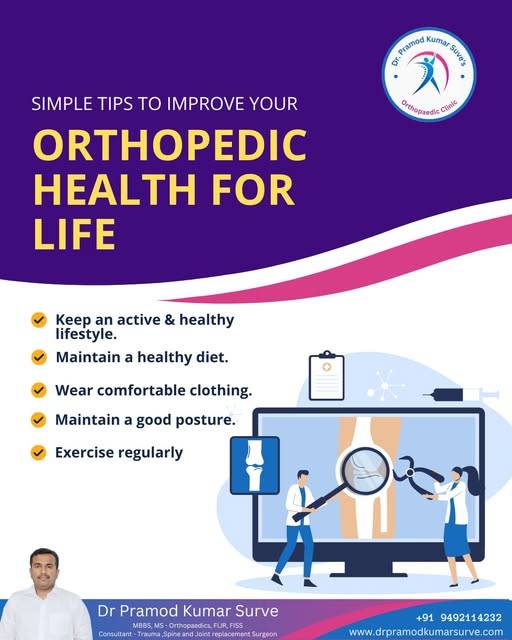
Maintaining good orthopedic health is essential for staying active and pain-free. Dr. Pramod Kumar shares practical tips to keep your bones, joints, and muscles strong:
Stay Active: Regular low-impact exercises like walking, swimming, or yoga strengthen muscles and improve joint flexibility.
Maintain a Healthy Weight: Extra weight puts stress on joints, especially knees and hips.
Eat a Balanced Diet: Include calcium- and vitamin D-rich foods for bone strength.
Practice Good Posture: Proper alignment reduces strain on your spine and joints.
Avoid Injuries: Use protective gear during sports and practice safe movement techniques.
Regular Checkups: Early detection of orthopedic issues can prevent long-term damage.
#joint replacement in hadapsar#knee replacement surgeon in hadapsar#shoulder replacement surgeon in hadapsar#hip replacemnt surgeon in hadpsar
0 notes
Text
Hip Replacement Surgery: Regain Mobility and Live Pain-Free

Chronic hip pain can significantly impact your daily life — from walking and sitting to getting restful sleep. If medications and physical therapy haven’t provided relief, hip replacement surgery could be the solution. At Dr. Pramod Kumar’s Orthopedic Clinic, patients receive expert care focused on restoring mobility and comfort.
What Is Hip Replacement Surgery?
Hip replacement surgery involves replacing the damaged parts of the hip joint with artificial implants. It is commonly recommended for individuals suffering from:
Osteoarthritis
Rheumatoid arthritis
Hip fractures
Avascular necrosis
Persistent hip pain and stiffness
When Should You Consider Surgery?
You may be a candidate for hip replacement if you experience:
Severe hip pain during walking, bending, or resting
Difficulty climbing stairs or standing up
Limited mobility or range of motion
No relief from medications, injections, or physiotherapy
Types of Hip Replacement
Total Hip Replacement: Both the ball and socket of the hip joint are replaced.
Partial Hip Replacement: Usually done for hip fractures, where only the ball is replaced.
Minimally Invasive Hip Replacement: Smaller incision, less tissue damage, and faster recovery.
What to Expect at Dr. Pramod Kumar’s Clinic
Personalized assessment and imaging
Clear guidance on surgical and non-surgical options
Advanced surgical techniques for faster recovery
Post-operative rehab and long-term support
Recovery & Results
Most patients regain mobility and enjoy a pain-free life within a few weeks to months. With proper care, hip implants can last 15–20 years or more.
Take the First Step Toward a Pain-Free Life Schedule a consultation with Dr. Pramod Kumar today to explore your options for hip replacement surgery at our trusted orthopedic clinic.
#joint replacement in hadapsar#knee replacement surgeon in hadapsar#shoulder replacement surgeon in hadapsar#hip replacemnt surgeon in hadpsar
0 notes
Text
Understanding the Risk Factors of Back Pain

Back pain is one of the most common reasons people visit doctors or miss work, and it can significantly impact daily life. While many cases of back pain resolve with rest or minor treatment, understanding the risk factors can help you prevent its onset and avoid chronic issues.
Dr. Pramod Kumar, a leading orthopedic doctor at his clinic in Pune, sheds light on the key causes and risk factors that contribute to back pain.
1. Poor Posture
Modern lifestyles often involve prolonged sitting—whether at a desk or while using a smartphone. Slouching or hunching places extra strain on the spine, leading to muscular imbalances and back pain.
2. Sedentary Lifestyle
Lack of regular physical activity weakens the core and back muscles, which are essential for spinal support. A sedentary lifestyle can make your spine more vulnerable to injury.
3. Obesity
Carrying excess weight puts additional pressure on your lower back, altering spinal alignment and contributing to conditions like herniated discs or sciatica.
4. Improper Lifting Techniques
Lifting heavy objects without proper technique—especially bending from the waist instead of the knees—can strain back muscles or even cause disc injuries.
5. Age
As we age, the spine undergoes natural wear and tear. Conditions like osteoarthritis and degenerative disc disease become more common in individuals over 40.
6. Smoking
Smoking reduces blood flow to the spinal discs, accelerating disc degeneration and delaying tissue healing after injury.
7. Psychological Factors
Stress, anxiety, and depression can lead to muscle tension and lower pain thresholds, contributing to chronic back pain in some individuals.
8. Genetic Predisposition
Some back conditions, like ankylosing spondylitis or scoliosis, may be hereditary, increasing your risk regardless of lifestyle.
9. Occupational Hazards
Jobs that involve heavy lifting, repetitive movements, or long periods of sitting or standing can increase the likelihood of developing back pain.
10. Previous Injuries
A history of back injury makes you more prone to recurrent or chronic back pain if not properly managed.
When to See a Specialist
If you're experiencing persistent or severe back pain, it’s important to consult an orthopedic specialist. Dr. Pramod Kumar offers expert evaluation and advanced treatments for back pain, tailored to your individual needs.
Book a Consultation Today
Take the first step toward a pain-free life. Visit Dr. Pramod Kumar’s Orthopedic Clinic in Pune for specialized care in back and spine disorders. Early intervention can prevent long-term complications and improve your quality of life.
#joint replacement in hadapsar#knee replacement surgeon in hadapsar#hip replacemnt surgeon in hadpsar
0 notes
Text
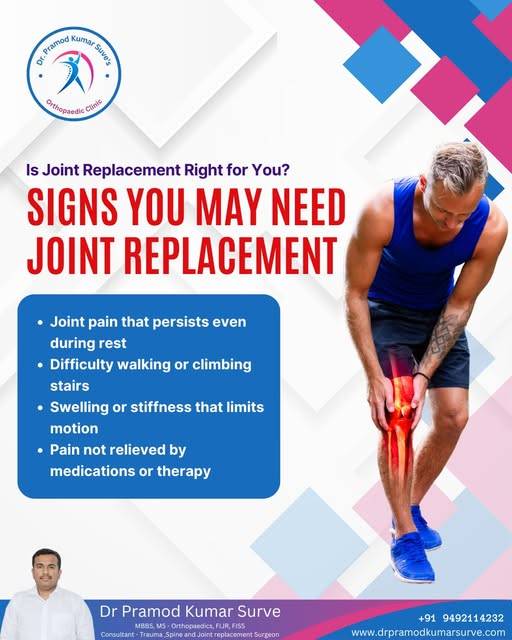
Before considering any joint replacement surgery, it's important to first monitor the symptoms carefully. If home remedies and pills fail to provide relief, and the condition continues to worsen, it is essential to consult an orthopedic surgeon for proper evaluation and effective treatment options. ✅ For best Joint Replacement Surgery Consult our joint specialist in Hadapsar, Pune and once again regain your mobility.
#joint replacement in hadapsar#knee replacement surgeon in hadapsar#shoulder replacement surgeon in hadapsar#hip replacemnt surgeon in hadpsar
0 notes
Text
Signs You May Need Joint Replacement
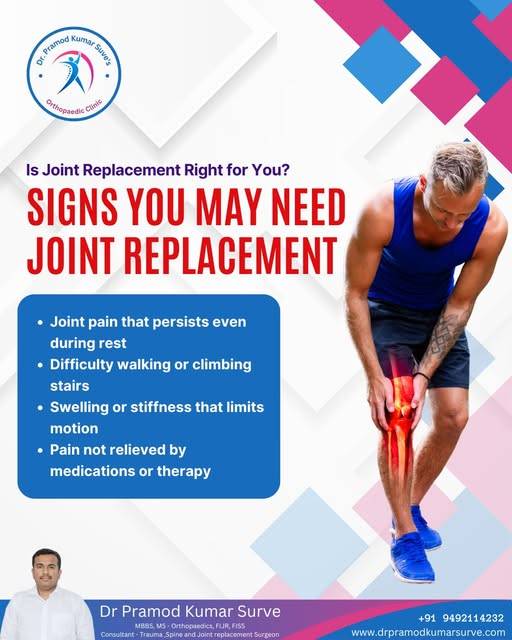
Are you struggling with constant joint pain that won’t go away, even with medication or physiotherapy? It might be more than just wear and tear. Joint replacement surgery could be the solution you need to restore movement and relieve pain. At Dr. Pramod Kumar’s Orthopedic Clinic in Hadapsar, we specialize in diagnosing and treating joint issues with advanced surgical and non-surgical techniques.
What Is Joint Replacement?
Joint replacement is a surgical procedure where damaged parts of a joint (like the knee, hip, or shoulder) are removed and replaced with prosthetic components. This surgery is often recommended when pain and dysfunction significantly impact daily life and conservative treatments no longer help.
7 Signs You May Need a Joint Replacement
1. Persistent Pain: If your joint pain persists day and night—even while resting or sleeping—it may be time to consult an orthopedic specialist. Chronic pain is one of the clearest signs that joint replacement might be necessary.
2. Limited Range of Motion: Do you find it hard to bend your knee, lift your arm, or rotate your hip? Stiffness and restricted movement can indicate severe joint damage that might be relieved with replacement surgery.
3. Difficulty with Daily Activities: When everyday tasks like climbing stairs, walking, getting out of a chair, or driving become difficult, your joint may no longer be functioning properly.
4. Swelling and Inflammation: Chronic joint swelling that doesn’t respond to medication or physical therapy could be a sign of joint degeneration and may require further evaluation.
5. Joint Deformity: Visible changes in the joint’s appearance, such as bowing legs or misaligned hips, suggest structural damage. Joint replacement can help restore alignment and function.
6. Ineffectiveness of Non-Surgical Treatments: If you've tried painkillers, injections, physiotherapy, and lifestyle modifications without lasting relief, it may be time to consider surgical options.
7. Reduced Quality of Life: When pain and mobility issues limit your independence and affect your mental and emotional well-being, joint replacement can significantly improve your quality of life.
Why Choose Dr. Pramod Kumar for Joint Replacement in Hadapsar?
Dr. Pramod Kumar is a trusted orthopedic surgeon in Hadapsar, Pune, with extensive experience in joint replacement surgeries, including total knee replacement, hip replacement, and shoulder joint surgeries. At our advanced orthopedic clinic, we use the latest surgical techniques and offer personalized care to ensure faster recovery and long-term success.
Take the First Step Toward Pain-Free Living If you’re experiencing any of the signs mentioned above, don’t wait for your condition to worsen. Book a consultation with Dr. Pramod Kumar today and explore the best treatment options for your joint health.
📍 Orthopedic Clinic in Hadapsar, Pune 📞 Call now to schedule an appointment.
#joint replacement in hadapsar#knee replacement surgeon in hadapsar#shoulder replacement surgeon in hadapsar#hip replacemnt surgeon in hadpsar
0 notes
Text

Joint pain can severely impact your mobility and overall quality of life. For those suffering from conditions like severe arthritis, joint damage, or injury, joint replacement surgery can be truly life-changing. Dr. Pramod Kumar, a highly experienced joint replacement surgeon, offers advanced and personalized treatment options that help patients regain movement, reduce pain, and return to their active lifestyle. Whether it’s a knee, hip, or shoulder replacement, Dr. Pramod Kumar ensures expert surgical care and long-term recovery support for optimal results.
#joint replacement in hadapsar#knee replacement surgeon in hadapsar#hip replacemnt surgeon in hadpsar
0 notes
Text
Don’t Ignore Hip Pain: When to Seek Help

Hip pain is often dismissed as a temporary discomfort — something that will go away with rest or over-the-counter painkillers. But persistent or worsening hip pain could be your body’s way of signaling an underlying orthopedic issue that needs expert attention.
Why You Shouldn’t Ignore Hip Pain
Your hip joint is one of the most important weight-bearing joints in your body. Whether it’s walking, climbing stairs, or simply sitting down, your hip is involved in nearly every movement. Ignoring hip pain may lead to:
Worsening of the condition
Joint damage
Reduced mobility
Chronic pain or disability
Common Causes of Hip Pain
According to Dr. Pramod Kumar, leading orthopedic specialist in Hadapsar, Pune, hip pain may be caused by:
Arthritis – Osteoarthritis or rheumatoid arthritis can wear down the joint.
Hip fractures – Especially common in elderly individuals due to bone weakness.
Tendonitis or bursitis – Inflammation of tendons or bursae can lead to pain and stiffness.
Labral tears – Injury to the cartilage lining of the hip socket.
Referred pain – Pain from the spine or pelvis can sometimes radiate to the hip.
When to See an Orthopedic Specialist
Visit Dr. Pramod Kumar at his orthopedic clinic in Hadapsar if you experience:
Pain that lasts more than a few days
Pain that interferes with walking or daily activities
Swelling, redness, or warmth around the hip
Difficulty in standing, sitting, or lying on one side
A snapping or clicking sound in the hip
Previous injuries or falls
Personalized Hip Treatment Options
Dr. Pramod Kumar offers comprehensive evaluation and tailored treatment plans, including:
Non-surgical solutions: Physiotherapy, medications, and lifestyle modifications.
Minimally invasive procedures: For specific injuries or chronic conditions.
Hip replacement surgery: For severe arthritis or hip damage, restoring mobility and reducing pain.
Final Thoughts
Hip pain is not something to live with or brush off. Early diagnosis and timely treatment can prevent complications and improve your quality of life. If you or your loved one is struggling with hip discomfort, don’t delay — consult Dr. Pramod Kumar, trusted orthopedic surgeon in Hadapsar, Pune.
0 notes
Text
When to Apply Ice for Injuries

Injuries can happen anytime—during a workout, a fall, or even a minor misstep. Knowing how to respond immediately can make a big difference in recovery. One of the simplest and most effective first-aid remedies is ice application. At Dr. Pramod Kumar’s Orthopedic Clinic in Hadapsar, we often guide patients on the importance of using ice for injuries. But when exactly should you use ice? Let’s explore.Why Apply Ice After an Injury?Ice therapy, also known as cryotherapy, helps to:Reduce swelling and inflammationNumb the area to relieve painConstrict blood vessels to control bleeding and bruisingMinimize tissue damageCommon Injuries Where Ice Helps1. Sprains and StrainsWhether it’s your ankle, wrist, or knee, a sudden twist can lead to a sprain or strain. Ice should be applied within the first 24–48 hours to control swelling and pain.2. Bruises and ContusionsIf you bang into something or fall, a bruise may form. Applying ice immediately can prevent the bruise from spreading and help reduce discoloration.3. Joint InjuriesFor injuries involving joints like the shoulder, elbow, or knee, ice can soothe pain and prevent excess fluid build-up around the joint.4. Post-Surgical SwellingAfter orthopedic surgeries like knee replacement or fracture fixation, controlled icing can help with postoperative swelling and discomfort.5. Tendonitis or Overuse InjuriesIf you’ve overused a joint—like tennis elbow or runner’s knee—icing after activity helps manage inflammation.How to Apply Ice CorrectlyUse an ice pack or wrap ice in a clean cloth.Apply for 15–20 minutes every 2–3 hours during the first 48 hours.Avoid applying ice directly on the skin to prevent frostbite.Elevate the injured area while icing for better results.When NOT to Use IceOn open wounds or infectionsIf you have circulation issues or conditions like diabetes (consult a doctor first)Beyond the first 48–72 hours if swelling has subsided—heat may be more appropriateNeed Expert Care for Your Injury?If your pain or swelling doesn’t improve, or if you’re unsure about the type of injury you’ve sustained, consult an expert. Dr. Pramod Kumar, one of the best orthopedic doctors in Hadapsar, offers personalized evaluation, accurate diagnosis, and effective treatment for all types of bone, joint, and muscle injuries.
#joint replacement in hadapsar#shoulder replacement surgeon in hadapsar#knee replacement surgeon in hadapsar#hip replacemnt surgeon in hadpsar
0 notes
Text
Understanding Fractures: Causes, Symptoms, and Treatment
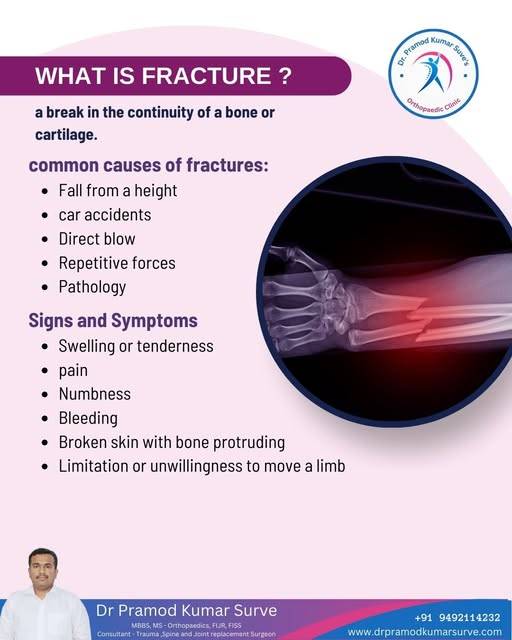
Fractures are one of the most common orthopedic injuries, affecting people of all ages. Whether caused by trauma, falls, or medical conditions like osteoporosis, fractures require prompt and proper medical attention for optimal healing. At Dr. Pramod Kumar’s Orthopedic Clinic, we specialize in diagnosing and treating various types of fractures, ensuring the best care for our patients.
What is a Fracture?
A fracture is a break or crack in a bone, which can range from a minor hairline crack to a complete break. Fractures can occur due to accidents, sports injuries, falls, or weakened bones from conditions such as osteoporosis.
Types of Fractures
Fractures are categorized based on their severity and nature, including:
Closed Fracture: The bone breaks but does not penetrate the skin.
Open (Compound) Fracture: The bone breaks and pierces through the skin, increasing the risk of infection.
Hairline Fracture: A small, thin crack in the bone that may not cause complete breakage.
Comminuted Fracture: The bone shatters into multiple pieces.
Greenstick Fracture: A partial fracture common in children, where the bone bends but does not completely break.
Stress Fracture: Often seen in athletes, caused by repetitive strain and overuse.
Symptoms of a Fracture
Identifying a fracture early is crucial for proper treatment. Common symptoms include:
Intense pain at the site of injury
Swelling and bruising
Deformity or unnatural positioning of the limb
Difficulty in movement or bearing weight
A cracking or popping sound at the time of injury
Diagnosis and Treatment
At Dr. Pramod Kumar’s Orthopedic Clinic, we use advanced diagnostic tools, including X-rays, CT scans, and MRIs, to accurately assess fractures.
Treatment Options:
Immobilization: Plaster casts or splints help in stabilizing the fracture for proper healing.
Medication: Pain relief and anti-inflammatory drugs aid in managing discomfort.
Surgery: In severe cases, surgical intervention with metal plates, screws, or rods may be required.
Physical Therapy: Rehabilitation exercises help restore mobility and strength post-recovery.
Preventing Fractures
Engage in weight-bearing exercises to strengthen bones.
Maintain a healthy diet rich in calcium and vitamin D.
Use protective gear during sports and physical activities.
Be cautious to prevent falls, especially for older adults.
Visit Dr. Pramod Kumar’s Orthopedic Clinic
If you or a loved one experiences a fracture, timely treatment is essential to avoid complications. At Dr. Pramod Kumar’s Orthopedic Clinic, we provide expert care, personalized treatment plans, and rehabilitation services to ensure a smooth recovery.
For consultations or emergency fracture care, book an appointment today!
Contact Us: 📍Location: Hadapsar, Pune 📞 Phone: +91 9492114232 🌐 Website: https://drpramodkumarsurve.com/Search
#joint replacement in hadapsar#shoulder replacement surgeon in hadapsar#knee replacement surgeon in hadapsar#hip replacemnt surgeon in hadpsar
0 notes
Text
Back Pain Home Remedies for Comfort
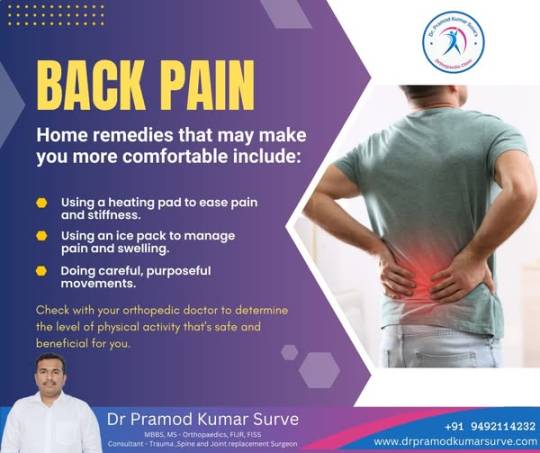
Back pain is a common issue that can affect people of all ages, impacting daily activities and overall well-being. While professional medical care is essential for chronic or severe back pain, some home remedies may help relieve discomfort and improve mobility. Dr. Pramod Kumar Surve, an experienced orthopedic specialist, shares simple and effective ways to ease back pain at home.
1. Apply Heat and Cold Therapy
Use an ice pack to reduce inflammation and numb the pain.
Apply a heating pad or warm compress to loosen tight muscles and improve circulation.
Alternate between hot and cold treatments for best results.
2. Stay Active with Gentle Exercises
Engage in low-impact activities like walking, swimming, or yoga.
Stretching exercises, such as the cat-cow stretch or knee-to-chest stretch, help relieve tension.
Avoid prolonged bed rest, as it can weaken muscles and worsen pain.
3. Maintain a Good Posture
Keep your spine aligned while sitting and standing.
Use an ergonomic chair and adjust your workspace to support proper posture.
Avoid slouching or hunching over screens.
4. Massage Therapy
A gentle back massage can help relax tight muscles and improve blood flow.
Using essential oils like peppermint or eucalyptus may provide additional relief.
5. Improve Sleep Posture
Sleep on a firm mattress with proper spinal support.
Use a pillow under the knees when sleeping on your back or between the knees when sleeping on your side.
Avoid sleeping on your stomach, as it can strain the spine.
6. Stay Hydrated and Eat a Healthy Diet
Proper hydration helps maintain spinal disc health.
Consume anti-inflammatory foods like leafy greens, nuts, and omega-3-rich fish.
Limit processed foods and excessive caffeine intake.
7. Try Herbal Remedies
Turmeric, ginger tea, and magnesium supplements may help reduce inflammation.
Herbal ointments with menthol or capsaicin can provide temporary pain relief.
8. Practice Stress Management
Stress can contribute to muscle tension and back pain.
Deep breathing, meditation, and relaxation techniques can help alleviate stress-related discomfort.
When to See a Doctor
If back pain persists for more than a few weeks, worsens over time, or is accompanied by numbness, weakness, or other concerning symptoms, consult an orthopedic specialist like Dr. Pramod Kumar Surve for a proper diagnosis and treatment plan.
Taking care of your back with these simple home remedies may help improve comfort and prevent further complications. However, always seek professional advice for persistent or severe pain.
#back pain#hip replacemnt surgeon in hadpsar#joint replacement in hadapsar#shoulder replacement surgeon in hadapsar#knee replacement surgeon in hadapsar
0 notes
Text
Tips to Prevent Back Pain

Back pain is a common issue that affects people of all ages and lifestyles. Whether it’s due to poor posture, a sedentary lifestyle, or heavy lifting, back pain can interfere with daily activities and overall well-being. Fortunately, there are several ways to prevent back pain and maintain a healthy spine. Dr. Pramod Kumar, a renowned orthopedic specialist, shares expert advice on how to keep your back pain-free.
1. Maintain Good Posture
Poor posture is one of the leading causes of back pain. Whether sitting, standing, or walking, always keep your spine aligned. When sitting at a desk, ensure your feet are flat on the ground, your back is supported, and your shoulders are relaxed.
2. Exercise Regularly
Engaging in regular physical activity strengthens the muscles that support your spine. Low-impact exercises like swimming, walking, and yoga help improve flexibility and core strength, reducing the risk of back pain.
3. Lift Objects Properly
Incorrect lifting techniques can strain your back. Always bend at the knees and use your legs, rather than your back, to lift heavy objects. Keep the object close to your body and avoid twisting your torso while lifting.
4. Maintain a Healthy Weight
Excess weight puts additional pressure on the spine, increasing the risk of back pain. A balanced diet and regular exercise help maintain an optimal weight and reduce strain on the back muscles.
5. Sleep in a Proper Position
Your sleeping posture can impact your back health. Choose a mattress that provides proper support, and avoid sleeping on your stomach, as it can strain the spine. Sleeping on your back or side with a pillow between your knees can help keep your spine aligned.
6. Avoid Prolonged Sitting
Sitting for extended periods can lead to stiffness and back pain. Take breaks every 30���60 minutes to stand, stretch, and move around. Using an ergonomic chair can also help maintain proper spinal alignment.
7. Stay Hydrated
Drinking enough water keeps the spinal discs hydrated, which helps in maintaining their flexibility and shock-absorbing abilities. Dehydration can lead to disc degeneration and increased back pain.
8. Manage Stress
Chronic stress can cause muscle tension, leading to back pain. Incorporate relaxation techniques such as deep breathing, meditation, and stretching to reduce stress and keep your muscles relaxed.
9. Wear Supportive Footwear
Shoes that lack proper support can affect spinal alignment and cause back pain. Choose footwear that provides adequate cushioning and arch support to maintain good posture and reduce stress on your back.
10. Visit an Orthopedic Specialist
If you experience persistent or severe back pain, seeking professional help is crucial. Dr. Pramod Kumar specializes in diagnosing and treating various orthopedic conditions, including back pain. Early intervention can prevent complications and ensure effective treatment.
Conclusion
Preventing back pain involves a combination of good posture, regular exercise, and healthy lifestyle choices. By following these expert tips from Dr. Pramod Kumar’s Orthopedic Clinic, you can keep your spine healthy and pain-free. If you’re struggling with back pain, consult Dr. Pramod Kumar for personalized care and effective treatment solutions.
Book an Appointment Today!
#joint replacement in hadapsar#shoulder replacement surgeon in hadapsar#knee replacement surgeon in hadapsar#hip replacemnt surgeon in hadpsar#back pain
0 notes
Text
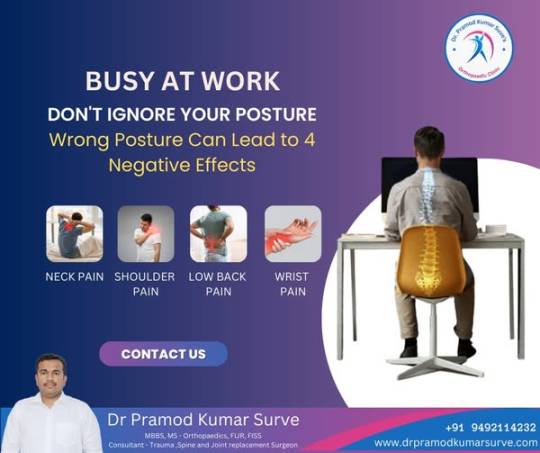
𝐖𝐫𝐨𝐧𝐠 𝐩𝐨𝐬𝐭𝐮𝐫𝐞 can cause back, neck, and joint pain, headaches, poor circulation, and even nerve compression, leading to long-term spinal issues. Severe cases may result in 𝐜𝐡𝐫𝐨𝐧𝐢𝐜 𝐩𝐚𝐢𝐧, 𝐫𝐞𝐝𝐮𝐜𝐞𝐝 𝐦𝐨𝐛𝐢𝐥𝐢𝐭𝐲, 𝐚𝐧𝐝 𝐦𝐮𝐬𝐜𝐥𝐞 𝐢𝐦𝐛𝐚𝐥𝐚𝐧𝐜𝐞𝐬. If you experience persistent pain, numbness, weakness, or posture-related discomfort affecting daily life, consult 𝐃𝐫. 𝐏𝐫𝐚𝐦𝐨𝐝 𝐊𝐮𝐦𝐚𝐫 𝐒𝐮𝐫𝐯𝐞 𝐢𝐧 𝐇𝐚𝐝𝐚𝐩𝐬𝐚𝐫, 𝐏𝐮𝐧𝐞, for the best effective treatment and care.
#joint replacement in hadapsar#shoulder replacement surgeon in hadapsar#knee replacement surgeon in hadapsar#hip replacemnt surgeon in hadpsar#back pain
0 notes
Text
Busy at Work? Don’t Ignore Your Posture – 4 Negative Effects of Wrong Posture

Introduction
In today’s fast-paced work environment, long hours at the desk, constant screen time, and improper ergonomics contribute to poor posture. Many people don’t realize the harmful effects of maintaining a wrong posture until they experience discomfort or pain. Dr. Pramod Kumar, a leading orthopedic specialist, highlights the importance of proper posture and its role in maintaining overall health. Here, we discuss four major negative effects of poor posture and why you should correct it immediately.
1. Neck and Back Pain
One of the most common consequences of poor posture is persistent neck and back pain. Slouching or hunching forward while sitting puts excessive strain on the spine, leading to muscle imbalances and discomfort. Over time, this can result in chronic pain, reduced flexibility, and even spinal disorders.
2. Increased Risk of Joint Problems
Incorrect posture can put unnecessary stress on your joints, particularly in the shoulders, hips, and knees. This misalignment can lead to joint degeneration, increasing the risk of arthritis and other musculoskeletal issues. Dr. Pramod Kumar advises regular stretching and posture correction exercises to prevent long-term joint damage.
3. Poor Circulation and Digestion
Sitting in a slouched position compresses your abdominal organs, leading to poor digestion and circulation. This can cause issues such as bloating, acid reflux, and even cardiovascular problems over time. Maintaining an upright posture ensures better blood flow and optimal organ function.
4. Reduced Lung Capacity and Energy Levels
Slouching can compress the lungs, reducing their capacity to expand fully. This leads to shallow breathing, decreased oxygen intake, and lower energy levels. Proper posture improves breathing efficiency, keeping you more alert and active throughout the day.
How to Improve Your Posture?
Ergonomic Setup: Ensure that your workstation is ergonomically designed to support a natural posture.
Regular Breaks: Stand up, stretch, and move around every 30–60 minutes.
Core Strengthening: Engage in exercises that strengthen your core muscles to support better posture.
Mindful Sitting: Keep your back straight, shoulders relaxed, and feet flat on the floor while working.
Conclusion
Ignoring your posture can lead to serious health complications over time. By making small but consistent changes, you can prevent pain, improve mobility, and enhance your overall well-being. If you’re experiencing persistent pain or posture-related issues, consult Dr. Pramod Kumar, an expert in orthopedic care, for professional guidance and treatment.
Take care of your posture today for a healthier tomorrow!
#joint replacement in hadapsar#shoulder replacement surgeon in hadapsar#knee replacement surgeon in hadapsar#hip replacemnt surgeon in hadpsar#back pain
0 notes
Text

Joint replacement surgery is a life-changing procedure designed to relieve chronic joint pain, restore mobility, and improve the overall quality of life. Whether due to arthritis, injury, or degenerative conditions, damaged joints can severely impact daily activities. Dr. Pramod Kumar Surve, a leading orthopedic specialist in Hadapsar, offers advanced joint replacement solutions, including knee and hip replacements. With his expertise, patients regain function, experience pain relief, and return to an active lifestyle.
#joint replacement in hadapsar#shoulder replacement surgeon in hadapsar#hip replacemnt surgeon in hadpsar#knee replacement surgeon in hadapsar
0 notes
Text
Importance of Joint Replacement Surgery

Joint pain and mobility issues can significantly impact one’s quality of life, making even simple activities like walking, climbing stairs, or bending difficult. When conservative treatments such as medication, physical therapy, and lifestyle modifications fail to provide relief, joint replacement surgery becomes a viable option.
What is Joint Replacement Surgery?
Joint replacement surgery involves replacing damaged or diseased joint surfaces with artificial implants, usually made of metal, plastic, or ceramic. The most common types of joint replacements are knee and hip replacements, but shoulder, elbow, and ankle replacements are also performed based on the patient’s needs.
Importance of Joint Replacement Surgery
1. Pain Relief
Chronic joint pain due to arthritis, injury, or degenerative conditions can be debilitating. Joint replacement surgery effectively alleviates persistent pain and helps individuals regain comfort in their daily lives.
2. Restoring Mobility
Severe joint damage often limits movement, making simple tasks challenging. By replacing the damaged joint with a prosthetic, mobility is restored, allowing patients to move more freely and resume an active lifestyle.
3. Improved Quality of Life
Pain and restricted movement can affect emotional well-being and overall happiness. Joint replacement surgery improves physical function, allowing individuals to participate in activities they enjoy without discomfort or limitations.
4. Correcting Deformities
Conditions like osteoarthritis and rheumatoid arthritis can lead to joint deformities over time. Joint replacement surgery helps in realigning and correcting these deformities, improving both function and appearance.
5. Enhancing Long-Term Health
Limited mobility due to joint problems can lead to a sedentary lifestyle, increasing the risk of other health conditions such as obesity, heart disease, and diabetes. Restoring movement through surgery encourages an active lifestyle, promoting better overall health.
When Should You Consider Joint Replacement Surgery?
While joint replacement is a highly effective procedure, it is usually recommended when:
Persistent pain interferes with daily activities.
Non-surgical treatments no longer provide relief.
There is significant joint damage visible on imaging tests.
The joint is severely deformed or unstable.
Why Choose Dr. Pramod Kumar Surve for Joint Replacement Surgery?
Dr. Pramod Kumar Surve is a highly experienced orthopedic surgeon specializing in knee replacement, total hip replacement, spine surgery, deformity correction, arthroscopic surgery, sports injuries, fracture, and trauma management. With a patient-centric approach, advanced surgical techniques, and a high success rate, he ensures optimal recovery and improved quality of life for his patients.
Conclusion
Joint replacement surgery is a life-changing procedure that restores mobility, eliminates pain, and improves overall well-being. If you or a loved one are struggling with chronic joint pain, consulting a specialist like Dr. Pramod Kumar Surve can help determine the best course of action to regain a pain-free and active life.
For expert orthopedic care, book a consultation with Dr. Pramod Kumar Surve today!
#joint replacement in hadapsar#shoulder replacement surgeon in hadapsar#hip replacemnt surgeon in hadpsar#knee replacement surgeon in hadapsar
0 notes